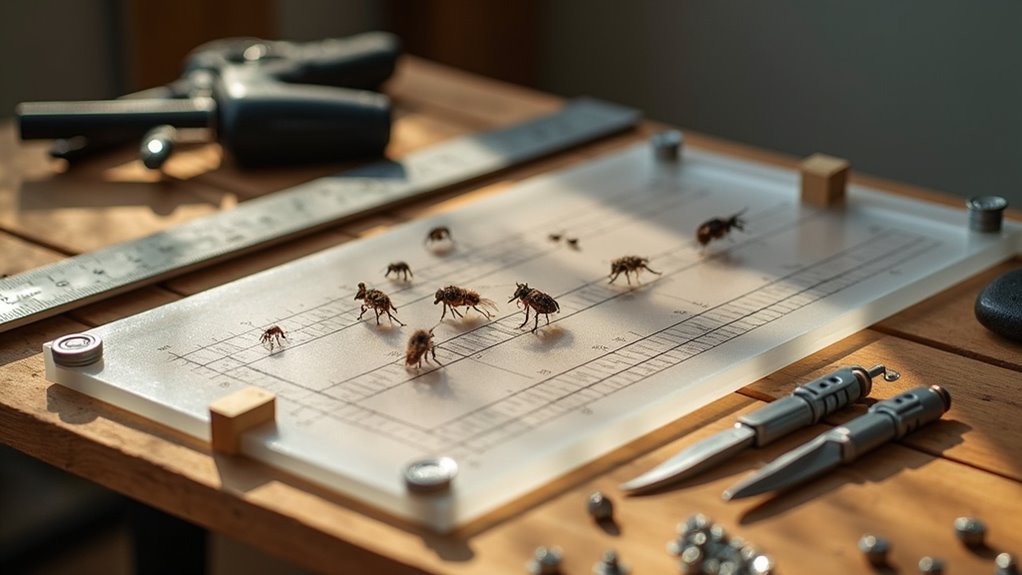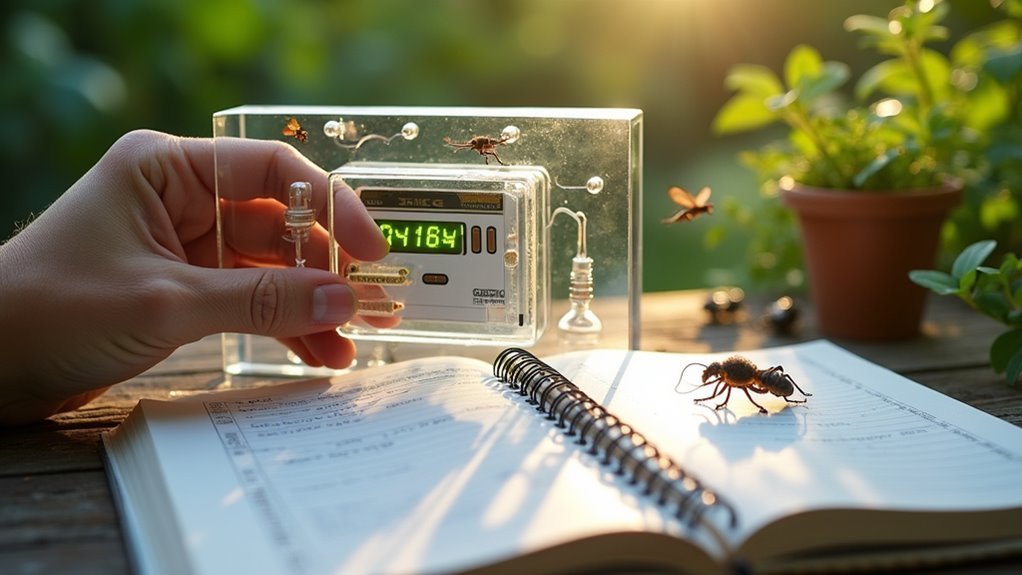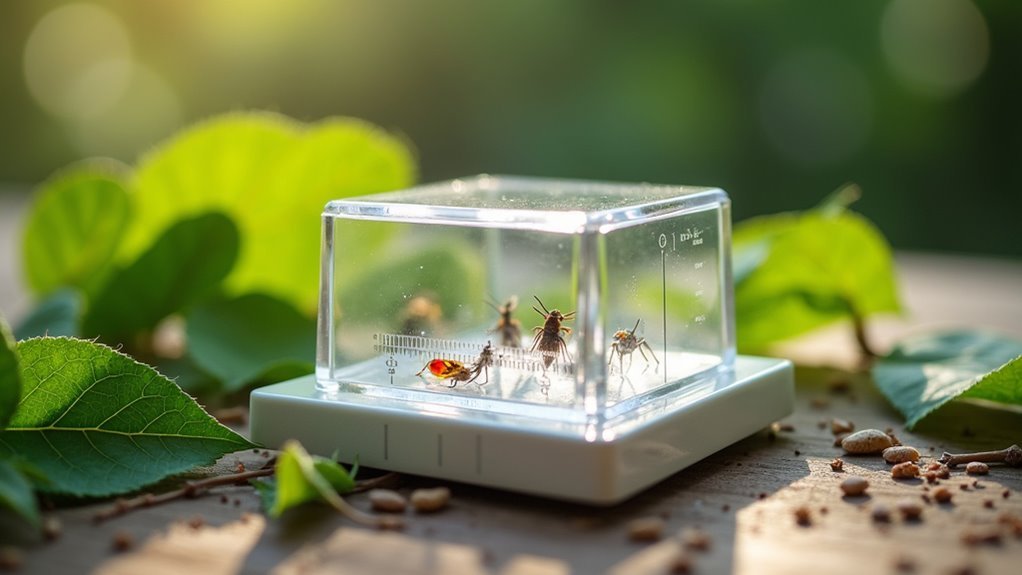A homemade pest density counter is a DIY monitoring device you’ll build using a high-resolution camera or smartphone, image processing software like OpenCV, and measurement tools to calculate pest populations per square meter. You’ll capture images of monitoring areas, then use computer vision algorithms to detect and count pests automatically. This cost-effective system requires basic materials like a tripod, LED lighting, and yellow sticky traps for baseline measurements. Continue exploring to discover assembly techniques and placement strategies.
Understanding Basic Pest Density Measurement Principles

When you’re building a homemade pest density counter, you’ll need to grasp the fundamental principle that drives all pest measurement: calculating how many pests occupy a specific area within a given timeframe.
This pest density measurement forms the backbone of your counting system, typically expressed as pests per square meter or square foot.
You’ll find that density maps prove invaluable for visualizing your data. These maps normalize your pest counts into Gaussian distributions, making it easier to quantify populations in crowded environments where manual counting becomes challenging.
Two factors are essential for accurate results: your sampling area’s size and observation duration.
These variables directly impact measurement reliability, so you’ll want to standardize them consistently across all your counting sessions to guarantee meaningful data.
Essential Materials and Tools for Building Your Counter
Success in building your pest density counter hinges on gathering the right materials and tools before you begin construction.
Proper preparation and material selection form the foundation of any effective pest monitoring system construction project.
You’ll need a high-resolution camera or smartphone capable of small object detection to capture clear pest images. A computer with image processing software like OpenCV or MATLAB is essential for analyzing captured data—this information is vital for accurate counting.
A stable tripod guarantees consistent positioning for reliable comparisons between monitoring sessions. Yellow sticky traps serve as visual references, providing baseline measurements that are widely used in pest monitoring applications.
LED lighting improves visibility, especially in poorly lit environments where pests commonly gather.
These fundamental components work together to create an effective monitoring system that delivers precise pest density measurements for your specific needs.
Step-by-Step Assembly Process for Homemade Density Counters

Now that you’ve collected your materials and tools, begin assembly by setting up your camera mounting system. Position your smartphone or camera at a fixed distance from your pest monitoring area to guarantee consistent image capture.
Install computer vision software on your computer and configure basic detection parameters. Create a calibration protocol by photographing known quantities of pests – this prevents small target detection errors that could adversely affect counting accuracy.
Implement the Gaussian distribution algorithm to normalize pest locations within captured images. Set up density mapping calculations using your chosen computer vision library.
Test your system by taking sample images and comparing automated counts with manual counts. Fine-tune detection sensitivity and adjust density estimation parameters based on initial results to optimize performance.
Strategic Placement Locations Throughout Your Property
You’ll maximize your pest monitoring effectiveness by strategically positioning your homemade density counters across two key coverage areas.
Indoor monitoring zones should target high-traffic pest areas like entry points, windows, and foundation cracks where insects commonly infiltrate your home.
Outdoor perimeter coverage extends your surveillance beyond your walls, creating an early warning system that detects pest populations before they reach your living spaces.
Indoor Monitoring Zones
Although homemade pest counters provide valuable data, their effectiveness depends entirely on where you position them throughout your home.
You’ll want to focus on high-traffic areas where pests commonly enter and gather: entryways, kitchens, and basements. Place glue boards strategically in corners and behind appliances to capture pests while monitoring their movement patterns and population density.
Water sources and food storage areas require special attention since they attract fruit flies and rodents. Position your monitoring devices near sinks, pantries, and anywhere moisture accumulates.
You can’t simply set these traps and forget them—regular checking and maintenance guarantees early detection before populations escalate. Combine visual inspections with your homemade monitoring tools for thorough data collection, giving you the complete picture of pest activity in your designated indoor zones.
Outdoor Perimeter Coverage
Creating a defensive perimeter around your property’s exterior requires strategic placement of monitoring devices at key entry points and vulnerable areas. You’ll want to position traps around doorways and window sills to create an effective barrier that monitors pests attempting entry. Install glue boards along your foundation and corners where insects typically congregate.
| Location | Purpose | Monitoring Method |
|---|---|---|
| Doorways/Windows | Entry prevention | Glue traps |
| Foundation corners | Activity detection | Glue boards |
| Garage areas | Access control | Regular inspection |
| Yard perimeter | Property protection | Granule treatments |
Apply a 12-inch treatment barrier using bifenthrin around your home’s exterior perimeter. Don’t forget your garage—monitor doors and cracks regularly. Implement overlapping granule treatments like Andro Quick Kill across your yard for extensive coverage against various pests throughout your entire property.
Recording and Interpreting Pest Population Data

Once you’ve constructed your homemade pest density counter, you’ll need to systematically record and analyze the data it provides to make informed decisions about pest management. Mark pest presence on your grid system and calculate population density by dividing total recorded pests by the grid area. This gives you a clear abundance estimate.
Regular data collection helps identify population trends and enables early infestation detection. Here’s how to interpret your data effectively:
- Establish baseline population density before monitoring changes
- Track significant increases that trigger intervention measures
- Document environmental factors like temperature and humidity
- Record data consistently at regular intervals
- Compare current readings against historical patterns
Combining pest counts with environmental data enhances understanding of pest behavior and informs targeted management strategies.
Maintenance and Calibration of Your DIY Device
You’ll need to establish consistent maintenance routines to keep your pest density counter operating at peak performance.
Start by implementing regular cleaning procedures for lenses and sensors, then develop systematic accuracy testing methods to verify your device’s counting precision.
Create a component replacement schedule that anticipates wear on critical parts before they compromise your monitoring results.
Regular Cleaning Procedures
A well-maintained pest density counter delivers reliable data that’s essential for effective pest management decisions.
Regular cleaning procedures guarantee your device operates at peak performance and extends its operational lifespan.
You’ll need to establish consistent cleaning protocols to prevent dust and debris from compromising your counter’s accuracy:
- Clean lenses and sensors weekly using appropriate electronic-safe solutions
- Handle all components delicately to avoid damage during maintenance
- Remove any obstructions that could interfere with pest detection capabilities
- Use lint-free cloths to prevent scratching sensitive surfaces
- Inspect for wear patterns or potential component failures during each cleaning session
Document every cleaning session in your maintenance logbook, noting any performance issues or concerns.
This systematic approach helps you identify degradation patterns before they affect your pest monitoring accuracy.
Accuracy Testing Methods
Beyond maintaining clean components, testing your device’s counting accuracy determines whether your pest monitoring efforts produce meaningful results.
Start by calibrating your counter against known pest population densities to establish a reliable baseline. Create a controlled testing environment where you can manipulate and measure pest densities accurately to validate your device’s performance.
Compare your DIY counter’s results with established counting methods like yellow sticky traps. This comparison reveals how well your homemade device performs against proven techniques.
Document any counting discrepancies you discover during testing. Use this data to adjust your device’s algorithm or detection parameters, improving precision and reducing error rates.
Regular accuracy testing guarantees your pest density counter remains a dependable tool for monitoring infestations effectively.
Component Replacement Schedule
Since reliable pest monitoring depends on properly functioning components, establishing a structured replacement schedule prevents equipment failures that compromise your data collection.
Your homemade pest density counter requires systematic maintenance to deliver consistent results. Following a proper timeline guarantees peak performance and extends your device’s lifespan.
- Replace sensors every six months to maintain accurate readings and prevent degradation
- Calibrate monthly using known pest densities to adjust sensitivity and counting accuracy
- Clean optical components weekly to remove dust and debris affecting detection precision
- Update software algorithms quarterly to incorporate latest pest recognition technology improvements
- Maintain detailed logs of all maintenance activities to track performance trends and identify issues
This proactive approach minimizes downtime while maximizing your counter’s effectiveness in monitoring pest populations consistently.
Comparing Homemade Vs Commercial Monitoring Systems
When you’re deciding between building your own pest density counter or investing in a commercial system, you’ll face distinct trade-offs in accuracy, cost, and convenience.
| Feature | Homemade Systems | Commercial Systems |
|---|---|---|
| Accuracy | Basic manual counting methods | R scores up to 0.973 for whiteflies |
| Cost | Low initial investment | Higher upfront costs |
| Automation | Requires frequent manual intervention | Automated counting with minimal labor |
| Technology | Simple materials and methods | Advanced algorithms and machine learning |
Commercial systems offer superior precision through multi-scale object detection and adaptive algorithms that you can’t easily replicate at home. While your homemade counter saves money upfront, commercial solutions provide ongoing research support and continuous improvements. You’ll need to weigh whether the cost savings justify the reduced accuracy and increased manual work.
Frequently Asked Questions
How to Make Homemade Pest Control?
You’ll mix equal parts water and vinegar in a spray bottle for insect repellent. Dust diatomaceous earth around entry points, create soap spray with dish soap and water, or use diluted essential oils like peppermint.
How to Calculate Insect Density?
You’ll calculate insect density by counting total insects in a specific area, then dividing by the surveyed area size. Use repeated sampling over time for accuracy and express results as individuals per square meter.
What Is the Best Measure to Combat Pest Like Rodents?
You’ll combat rodents best by combining snap traps and glue boards, sealing entry points around pipes and walls, removing food sources like pet food, and using tamper-resistant bait stations with rodenticides safely.
What Are Some Natural Pest Repellents?
You can use essential oils like peppermint and lavender, diatomaceous earth, white vinegar for ants, garlic sprays for mosquitoes, and neem oil against various insects as effective natural pest repellents.
In Summary
You’ve now got the knowledge to build and deploy your own pest density counter effectively. By understanding measurement principles, gathering the right materials, and following proper assembly steps, you’ll create a reliable monitoring system. Remember to place your counters strategically, record data consistently, and maintain your devices regularly. While commercial systems offer convenience, your homemade counter provides cost-effective pest monitoring that’s tailored to your specific property needs.





Leave a Reply